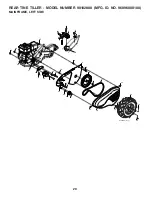
10
TILLING HINTS (See Fig. 14)
CAUTION: Until you are accustomed to
handling your tiller, start actual field use
with throttle in slow position (mid-way
between “FAST” and “IDLE”).
• Tilling is digging into, turning over, and breaking up
packed soil before planting. Loose, unpacked soil helps
root growth. Best tilling depth is 4" to 6" (10-15 cm).
A tiller will also clear the soil of unwanted vege ta tion.
The de com po si tion of this vegetable mat ter enriches
the soil. Depending on the climate (rain fall and wind),
it may be advisable to till the soil at the end of the
growing season to further condition the soil.
• You will find tilling much easier if you leave a row
untilled between passes. Then go back between tilled
rows. (See Fig. 14) There are two reasons for doing
this. First, wide turns are much easier to negotiate than
about-faces. Sec ond, the tiller won’t be pulling itself,
and you, toward the row next to it.
•
Soil conditions are important for proper tilling. Tines will
not readily penetrate dry, hard soil which may con trib ute
to excessive bounce and difficult handling of your tiller.
Hard soil should be mois tened before tilling; however,
extremely wet soil will “ball-up” or clump during tilling.
Wait until the soil is less wet in order to achieve the
best results. When tilling in the fall, re move vines and
long grass to prevent them from wrapping around the
tine shaft and slowing your tilling operation.
•
Do not lean on handle. This takes weight off the wheels
and reduces traction. To get through a really tough
section of sod or hard ground, apply upward pressure
on handle or lower the depth stake.
Fig. 14
Fig. 15
3
2
1
5
4
6
7
CULTIVATING
Cultivating is destroying the weeds between rows to pre-
vent them from robbing nourishment and moisture from the
plants. At the same time, breaking up the upper layer of
soil crust will help retain moisture in the soil. Best digging
depth is 1" to 3" (2.5-7.5 cm). Lower the outer side shields
to protect small plants from being buried.
• Cultivate up and down the rows at a speed which will
allow tines to uproot weeds and leave the ground in
rough condition, promoting no further growth of weeds
and grass (See Fig. 15).
ADJUST WHEELS FOR CULTIVATING
(See Figs. 16 and 17)
•
Place blocks under right hand side of tiller and remove
hairpin clip and clevis pin from right hand wheel.
• Move wheel outward approximately 1 inch until hole
in inner wheel hub lines up with inner hole in axle.
• Replace clevis pin and hairpin clip on inside of wheel
and remove blocks.
• Repeat preceding steps on left hand side.
NOTE
: In extremely rough conditions and while
cultivating, the wheels should be moved outward on the
axle for increased stability.
•
Do not lean on handle, this takes weight off the wheels,
reduces traction, and may cause the tiller to skip over
the ground.
•
Always lower the drag stake when using the for ward
rotating tine drive.
Fig. 16
Fig. 17
INNER VIEW
OF TIRE
CLEVIS PIN
HAIRPIN CLIP
OUTER VIEW
OF TIRE
HAIRPIN CLIP
CLEVIS PIN
OPERATION
Содержание 21547000
Страница 20: ...20 MAINFRAME LEFT REAR TINE TILLER MODEL NUMBER 90102800 MFG ID NO 96096000100 MAINFRAME LEFT SIDE...
Страница 28: ...28 REAR TINE TILLER MODEL NUMBER 90102800 MFG ID NO 96096000100 TINE ASSEMBLY...
Страница 30: ...30 16 7 8 18 9 6 3 2 10 15 4 17 REAR TINE TILLER MODEL NUMBER 90102800 MFG ID NO 96096000100 DECALS...











































